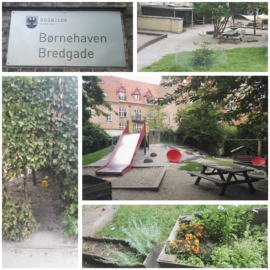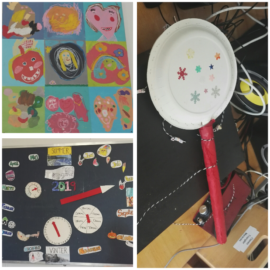Tuesday 27th of August 2019
Tuesday morning started with a nice quick breakfastbag at Steelhouse hostel where we were staying for the trip. By the sun went up and warmed the weather around 28 degrees we went again to the trainstation, which was by the way about 7 minutes’ walk from our hostel. There we took a train to Roskilde. It took about 28 minutes from Copenhagen to arrive Roskilde. The transportation system in Copenhagen is just amazing and easy! This is the second blog release from the second day by Sanna T. and Tiina T.
Børnehaven Bredgade
At Roskilde we went to Børnehaven Bredgade which is the oldest nursery in Roskilde. The buildings history is that it used to be a hospital before. At the gate we were met by kindergarten worker Lærke who showed us around the kindergarten and told us about their everyday routines. When we first saw the yard of the kindergarten, we were like wow! There were so many activities build on the yard where imagination is only the limit to children to play. The play outside is often created by the children themselves but they have also guided playtime.
Børnehaven Bredgade, Roskilde. Picture: Sanna Torvinen ja Tiina Tolvanen.
Lærke told us that they have different activities on different spots on the yard for example homeplay area, sandbox, slide, climbing frame, playfield for football and other running games, covered campfire place and even a little forest with small trees. They teach children to respect and value nature. For example, they have a planting day when children plant together with their grandparents a plant to garden boxes at the yard. Afterwards the children are involved on caring the flowers and vegetables they have planted and that way they learn to care nature. The art is also highly valued and brought outside in the form of paintings.
In Børnehaven Bredgade they have an annual plan of the activities they provide for the children and activities where the whole family is invited participate. The daily routine is similar to a Finnish kindergarten: morning starts with a shared morning where the children gather together, followed by a moment of activity and then dining and also daytime rest is provided for those who needs it after the meal, otherwise afternoon is spend at the playground. Singing and music is strongly involved in their everyday daycare. Food is made on their own kitchen or outside at the campfire and children are involved with the making of food. The feeling of warmth and presence is strong in the care of children. The main aspects of childcare are positivity, recognition and presence.
The pictures of the Børnehaven Bredgade, Roskilde. Picture: Sanna Torvinen ja Tiina Tolvanen.
We met also the Director of education Mikkel Ekeløf at the end of our visit. He told us about the political view of childcare at Roskilde and in Børnehaven Bredgade. Directors of education in Roskilde cooperate and have meetings. Staff members in Børnehaven Bredgade gather together with Mikkel repeatedly to evaluate pedagogical practice and make needed changes to improve. The pedagogics approach is quite similar to Finnish, for example an educational plan for every child with the parents is made which they follow, evaluate and document.
Staff uses a digital Pic Collage APP which allows the staff to import pictures of the child’s day in it and child’s parent has their own log on at home. That way they bring family closer to the happenings on daily bases at the kindergarten.
Links about Børnehaven Bredgade:
http://www.bredgade.roskilde.dk/om-os
Practice and Innovation House
After a visit to the kindergarten, we travelled back to Copenhagen to visit the Practice and Innovation House. We met project manager Ann Rasmussen there.
The Practice and Innovation House is part of Metropolitan University of Applied Sciences, Copenhagen. It develops welfare technology products in collaboration with companies, students, teachers and researchers. A company have a prototype of some product that can be tested and developed safely and extensively in Innovation House before it is put into use for example in a hospital.
Students can also practice different patient situations in the simulation rooms. The simulation room contains a control room from which the teacher or researcher can control and evaluate the situation. There is, among other things, a patient room, a medicine room and a simulation rooms from home, like a bedroom or a kitchen. The House also has two sensory rooms. One room relaxes and the other room provides sensory stimulation. The rooms are used to treat a variety of illnesses and symptoms.
The Practice and Innovation House. Picture: Sanna Torvinen ja Tiina Tolvanen.
Many ideas of the simulation rooms come from Finland but they want to be one step ahead, so they are constantly developing the use of the innovation house.
In our experience, there are simulation rooms in health care schools in Finland too, but maybe not as widely. Schools and businesses in Finland should also work more closely together to develop health and well-being. We also think that it is important that for example nurses, physiotherapists and midwifery students be able to work multi-professionally as students.
Links to about the Practice and Innovation House in Denmark:
https://www.phmetropol.dk/praksishuset/erhvervssamarbejde
The main feelings and ideas after Tuesday:
At Børnehaven Bredgade the yard was amazing, and we met lots of happy children playing and singing. The presence of the staff was very warm. Maby the communication between staff and children and the method of involving the children at everything they do is improving wellbeing?
Their digital approach to share the childs day on time with parents through APP was new to us.
The visit in the Practice and Innovation House opened our eyes to how welfare product development and studies can be done.
This blogipost is part of the welfare coordinator students (Master Degree Studies) study module Working and Stydying in International Environment. The focus of this stydy module is that the students can strengthen their communicative skills and professional experience in an international learning environment and learn effectively as a team member in another cultural environment. In August of 2019 part of welfare coordinator students visit in Denmark during this study module. You can read more www.savonia.fi.
Kirjoittajat:
Sanna Torvinen ja Tiina Tolvanen TYKO18SY
Riitta Turjamaa, lehtori Savonia-ammattikorkeakoulu
Pirjo Turunen, lehtori, Savonia- ammattikorkeakoulu



